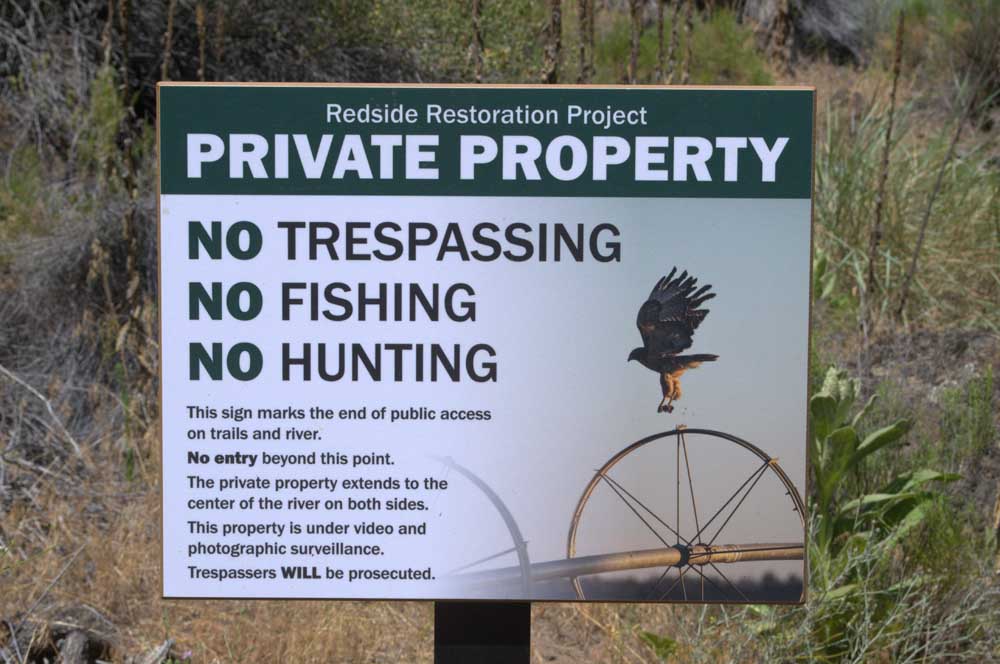River access a complicated question on the Deschutes
Published 3:30 am Tuesday, August 23, 2022

- A sign downstream of the Borden Beck Wildlife Preserve outside Terrebonne stating that private property extends to the center of the Deschutes River on both sides.
Joel Barker was fishing the Deschutes River outside Terrebonne early this summer, starting at the Borden Beck Wildlife Preserve and working his way downstream.
As he made his way to the next hole, Barker moved off public land into river that was surrounded on both sides by private property. At the edge of the river, a recently erected sign made him stop mid-cast to debate whether he could legally continue his pursuit of trout.
The sign read:
This sign marks the end of public access on trails and river.
No entry beyond this point.
The private property extends to the center of the river on both sides.
This property is under video and photographic surveillance.
Trespassers WILL be prosecuted.
Barker thought he had the right to fish the river through private land, but the sign confused him and he decided against it.
And he isn’t the only one confused about where his recreational rights end and the rights of the landowner begin. State law is vague about what qualifies as trespassing on the Deschutes, as well as other rivers throughout Central Oregon.
The confusion dates all the way back to 1859, when Oregon was first admitted as a state. At the time, all land underlying waterways that were used, or could be used, to transport goods and people became state-owned property — what is termed a “navigable river.”
However, back in 1859, no specific waterways were identified that met — or failed to meet— this navigability standard. That means that over the last century, it has been left to the State Land Board (and at times the judiciary and the legislature) to make the determination on a case-by-case basis in Oregon.
But no determination has ever been made on the Deschutes River, or the Crooked River for that matter.
The first step in that process is a navigability study request. According to Liane O’Neill, communications officer for the Department of State Lands, the organization “has been approached by a local group in the last couple of years with questions about a navigability study” on the Deschutes. However, O’Neill said that no navigability study request has officially been requested as of press time.
The Deschutes River Conservancy said it has not requested a study and has no stance either in support or opposition to defining the river’s navigability.
Though the Deschutes is not officially a navigable waterway, recreational users still have some rights.
Current guidance from the Oregon Department of State Lands for rivers that have not been deemed navigable is that that people “may float down publicly-owned waterways and they may stand or walk upon the beds or banks of the river below the ordinary high water line.”
According to Oregon’s Public Use Doctrine, anyone may float a river that is large enough to accommodate a boat, even if that water is not defined as publicly-owned. People may float that river while fishing, recreating, navigating, or other legal uses.
They may also use the beds and banks of the waterway below the ordinary high water line for water-dependent activities, such as swimming and fishing.
But to get to the river, water users have to be careful. In order to access the water from land above the ordinary high water line, water users must be on public land or receive permission from a private landowner. Otherwise they could legally be trespassing.
In the case of the signage downstream of Borden Beck, the person who posted the sign may indeed “own” the beds of the river within their tax lot. Surveillance of the river may be legal as well.
Sgt. Jayson Janes of the Deschutes County Sheriff’s Office said that the office does respond to calls of trespassing along the Deschutes and elsewhere in the county, where public/private property lines can sometimes be fuzzy. He recommends, “If you are not certain a portion of land is open to the public, it is safest to stay off of that land until you can confirm it is public land,” said Janes. “Many of the public trails along the river are pretty well marked.”





